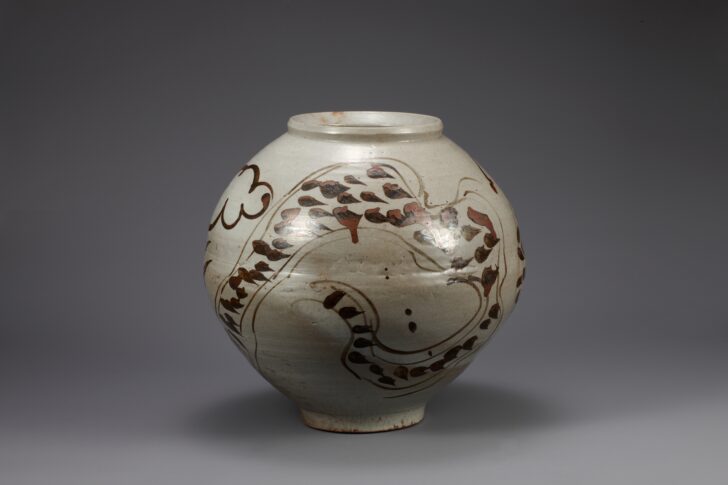Jar with abstract dragon design
Korean

Description
White porcelain with iron-brown underglaze began to be produced in the seventeenth century, after wars with Japan (1592–1598) and China (1636–1637) interrupted the supply of the cobalt pigment from China used in blue and white wares. After the seventeenth century, it became common for both o cial (managed by the Joseon court) and local kilns to use this technique, usually to depict owering plants,
or, as here, dragons and clouds. Although the
dragon was the symbol of a king in Korea, it
had also been pervasive as an auspicious symbol within the indigenous belief systems of ordinary people since the Three Kingdoms period (57 BCE– 676 CE). The motif of a dragon with clouds could denote the divine god ruling heaven, and was very popular during the Joseon dynasty.
Subject Matter:
Jar with abstract dragon design.
It was made for use in ceremonies at the royal courts.
Physical Description:
Round porcelain jar with iron pigment under colorless glaze. An abstract dragon spirals around and up the body of the piece, marked by quick brushstrokes indicating scales and unrestrained swirls indicating features such as its head and feet. A slight valley in the contour of the jar marks where two separately thrown pieces were joined together.
The foot is rather small for the size of the body.
This is a white porcelain jar decorated with iron-painted dragon, which wraps around the jar three times, displaying dynamic strokes of brush. The dragon’s head is not rendered; its two eyes have been tersely painted instead. Jars with iron painted dragons, rendered in an abstract from, were produced in large quantities in the 17th century; many of them were produed in regional kilns. Despite slight damage to its rim, this jar is preserved as intact. The central part of its body clearly shows that this jar was created by joining separately produced upper and lower halves.
[Korean Collection, University of Michigan Museum of Art (2014) p.166]
Usage Rights:
If you are interested in using an image for a publication, please visit https://umma.umich.edu/request-image/ for more information and to fill out the online Image Rights and Reproductions Request Form.